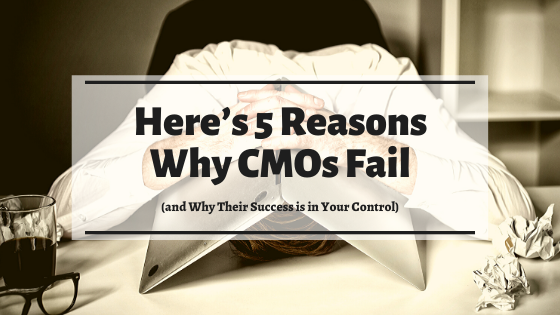Here’s 5 Reasons Why CMOs Fail (and Why Their Success is in Your Control)


If you’re struggling to keep a chief marketing officer on board, you’re not alone. CMO is a position with big challenges—and big turnover to match. Research firm SpencerStuart reports that in 2018, the average CMO only stayed on board for 43 months.
That’s a drop in CMO tenure for a second consecutive year. Why are CMOs leaving their companies in droves?
And more importantly, how can you keep your own CMO around?
It’s not cheap to replace a CMO. Employee churn costs around twice the lost employee’s salary. For a high-level role like CMO, that’s around $348,000 as of 2019.
Retaining your CMO for just five years at the current average rate saves you over $1,740,000. That’s why you can’t afford to keep losing your CMOs.
You can’t fix what you don’t understand, so take the time to learn why CMOs leave their posts prematurely. The most common reasons include:
-
Poor understanding of their role
-
Taking on the wrong responsibilities
-
Measuring the wrong metrics
-
Being a poor fit
-
Not having the full picture of the company vision
Understandably, all of these hiccups come together to form a barrier against success that can be too much to overcome for a new or seasoned CMO. The result is a failure, whether in the form of missed KPIs, slipped deadlines, resignment, or being fired.
How Can You Increase CMO Job Satisfaction?
You don’t have to resign yourself to rehiring a CMO every few years. All you have to do is understand why CMOs aren’t succeeding in their posts.
Chief marketing officer is a role that’s rapidly changing in the digital world. CMOs are constantly pivoting as digital marketing strategies evolve, primarily thanks to Google changes (but that’s far from all).
The result is a generation of CMOs who are scattered, overworked and don’t even know if they’re on the right track for success.
Of course, you’re only as successful as the framework that you’re given allows you to be. That means there’s a lot that you can do to help lift up your CMO from day one.
These are five reasons why CMOs are failing in 2019 and what you can do about it:

Photo by William Iven on Unsplash
#1: The CMO Role is Undefined
What is a chief marketing officer? If your CMO isn’t quite sure, then how is she supposed to succeed at it?
The role itself has so many definitions from company to company.
It’s a C-level executive who’s in charge of growth and sales.
It’s someone who creates and manages assets for an audience.
It’s someone who launches campaigns and manages ad spends.
The list could go on!
It’s not enough to simply recruit for a CMO without a detailed list of what that entails. Are there content campaigns to manage? Premium digital assets to produce? Writers, editors, and designers to hire and manage?
It’s all too common for a brand new CMO to show up ready to achieve the impossible, only to burn out fast as he struggles to figure out what’s expected from him.
That’s even truer if you’re recruiting people who have been in the CMO role before and may arrive with preconceptions about what being a CMO means.
Falling into old patterns is easy when you’ve been in a role before, but the CMO role is so specialized that you really have to be clear with your candidates about your expectations.
You should define your CMO role before you even post the job application.
#2: There’s a Mismatch of Roles and Responsibilities
How is your CMO spending his time? Are his responsibilities ones that align with his role expectations?
In a hierarchy where the CMO is a direct report to the CEO, it’s easy to hand your CMO tasks to lighten your own load, like reviewing KPIs from other departments or signing off on brand assets.
That’s not all. It’s common for new CMOs to pick up tasks of their own subordinates—for instance, taking on an assistant marketing officer’s communications task or writing copy.
It’s true that a team mentality brings nothing but success to teams that do it right… but “doing it right” doesn’t mean endless responsibilities on the shoulders of your CMO.
You may not even be aware of all the extra tasks that your CMO takes on, especially if they’re delegating to themselves without your knowledge.
But these extra tasks matter. The average CMO already works a 50-hour week to get all of her own responsibilities in. That’s without picking up CEO or subordinate tasks. Every minute your CMO spends doing a task that isn’t within his specialty is a minute that he can’t spend on meeting his own responsibilities.
Check in on your CMO regularly to see how they feel about their workload, responsibilities, and role alignment. Without harmony in those areas, even the most talented and passionate CMO is destined to burn out.

Photo by William Iven on Unsplash
#3: The Focus is on the Wrong Metric
How do you tell if your CMO is succeeding? Do you measure operational KPIs like cost per lead or cost per page view?
Newsflash: Operational KPIs are no longer the only reflection of what your CMO is doing.
Sure, these metrics are important. But strategic metrics are revenue- and growth-aligned while operational KPIs measure the effort and capital that you’re spending.
As the CEO, you should be setting your CMO up to manage strategic KPIs such as:
-
Customer acquisition cost: The total sales and marketing cost per time period divided by the number of new customers in that period.
-
Marketing percentage of CAC: This is solely a measure of the marketing cost for the CAC period (as opposed to sales costs). When this percentage is lower, it means you’re spending less on marketing.
-
Ratio of customer lifetime value to CAC: This metric is great for measuring recurring revenue streams or repeat purchases. It compares the current value of the customer to the current cost of acquiring a customer.
-
Time to payback CAC: The CAC divided by the margin-adjusted revenue per month for new customers is the time to payback CAC, or the magic number of days until your customers pay for their acquisition cost.
-
Marketing-originated customer percentage: This is the percentage of all new customers that arrived due to a marketing lead origination.
-
Marketing-influenced customer percentage: This is the percentage of all new customers that came into contact with your marketing during any time, not just origination.
Of course, these are just a few of the best KPIs for CMOs to follow. The KPIs that you’ll want to follow with your own CMO depend on factors like your industry and goals.
In fact, you should talk to your CMO about the metrics that you’ll be measuring their performance by. Since she’s the one doing the day-to-day work and working toward long-term goals, she may have insights about the best ways to measure the outcomes.
The fruits of your marketing efforts are more measurable than they’ve ever been. You and your CMO both can get a far better picture of how campaigns are performing in realtime by measuring strategic metrics in addition to operational ones.

Photo by You X Ventures on Unsplash
#4: The Culture Isn’t a Good Fit
CMO is a highly specialized role so you might be tempted to compromise on culture if your ideal candidate checks every other box.
But don’t do it!
Over half of CEOs say that culture affects their organization’s productivity, creativity, profitability, value, and growth.
If your CMO doesn’t reflect, embody, and embrace company culture to the fullest, then he’s destined to fail or move on. It’s impossible to produce an accurate marketing vision without being a cultural fit to a tee.
You can and should define your company culture in a way that reflects your organization’s:
-
Mission
-
Core values and principles
-
Ways of emulating and living those values
Write it down and make it part of the CMO job description. And talk about it during the job interview… exhaustively!
Admittedly, finding candidates can be hard depending on factors like location.
That’s why more companies are choosing to open up their pool of candidates with the help of a recruiting service. It’s worth the investment since it instantly increases the odds that you’ll find that perfect candidate.
#5: They Don’t Know the Company Vision
Did you know that 67% of CEOs don’t believe their CMOs know where the organization is going?
A marketing officer’s entire job is about reflecting the company vision into communications and deliverables—but too often a new CMO gets swamped in KPIs before taking the time to learn what your organization is about in terms of long-term goals.
CMOs who feel invested in the long-term vision get greater satisfaction out of their day-to-day. They can see their actions every day lead up to achieving goals far greater than quarterly KPIs.
As a CEO, you need to have a five- and 10-year plan and talk about it every time you enter the C-suite!
Ask yourself:
-
Where will we be in a year? In five, in 10?
-
What markets can we penetrate in that time period?
-
What’s the next product or service offering?
-
When are we going to be a household name? (That’s right, aim big!)
And again… talk about it. Talk about it at lunch, at the scrum meeting, on Slack, and over the water cooler. Then talk about it some more.
Your long-term plan is not motivating anyone if you’re not making it part of the day-to-day. Every member of the corporate team should know the long-term vision backward and forward, and your CMO is no exception.
You Control Your CMO’s Success
Luckily, every single one of these factors is within your control. There’s no reason to despair about your next CMO hire when it could be your last one for years! Now you have the tools to recruit mindfully and set your officer up for success.
You can write a better description of what a CMO does and be more articulate about your expectations.
You can check in with your CMO to ask how she feels about her workload and responsibilities… and then take action based on her response.
You can choose metrics to follow that accurately reflect CMO success (and drop the metrics that don’t).
You can be picky during the hiring process and make sure that your company and the candidate are the absolute best fit.
And you can be vocal about your company vision. Talk about what you do and why you do it. Every employee under your roof should know the five-year plan. It’s a sin if your CMO doesn’t know it!
There’s no reason your next CMO can’t be the perfect fit. How are you going to make it happen?
Resources
- https://www.spencerstuart.com/research-and-insight/chief-marketing-officer-average-tenure-drops-to-43-months
-
https://www.glassdoor.com/Salaries/chief-marketing-officer-salary-SRCH_KO0,23.htm

